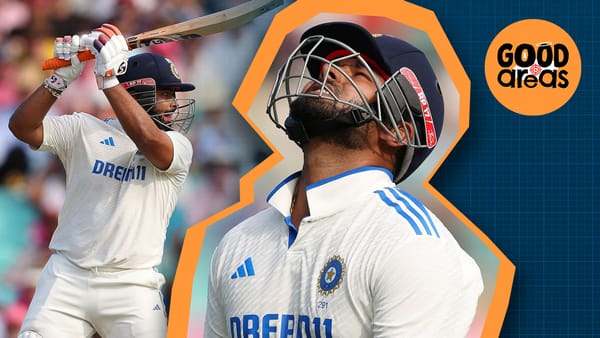England's medium-fast glut
The best bowlers, but not the quickest, get it done.
You will probably not have heard of Ken Higgs. But When he played in them he took 71 wickets at 20.74.
In New Zealand, he played three matches and averaged 9.74. In the UK he averaged around 23, which was his first-class mark. Ken Higgs was a fantastic cricketer.

His career also spanned a very long time. 10,340 days. Or 28 years, 3 months and 21 days. He started in 1958 and finished his career in 1986. However, he retired in 1970, then in 1972 made a comeback with Leicestershire before retiring again in the early 80s. But in 1986 he played two more matches.

That is because he was the Leicestershire bowling coach, and they were short of players, so he made a comeback. In his first match, he came on as the second change and only went and took a five-wicket haul against Yorkshire. In that attack was Phil DeFreitas. The point is that he's no ordinary bowler, he was great in Tests and took a five-for at the age of 49.

You might be justified in wondering why I have spent all this time speaking about the great Ken Higgs. It's not just the berserk backside or even the weird curved run-up on the way in. It's what Ken Higgs represents, England's medium-fast seam bowling in perfection. And yet in 1968, this beast of a seam bowler would play his final Test.
Why? Because at any one time, England has a bucketload of Ken Higgs around. You are what your conditions dictate in Tests, and English cricket produces line and length wobblers more than anyone else ever has.
You see them playing club cricket, on village greens or right throughout the lower levels of English pro cricket. Jogging in, placing it on a line, nipping it both ways. Batting in English cricket is overcoming their nagging metronomic boring existence. There is no doubt that England is the home of the medium-fast seamers.
That is what we have in this Test. England may have chosen Mark Wood for this match if they knew just how dire the surface would be. Getting his pace on this wicket would have been interesting, especially with his lower trajectory.
But Wood has struggled on good batting decks in Edgbaston before, and also, he's not been good in England. Chances are that England thought this was their best bowling attack, and with Jofra Archer's injuries, it would be hard to argue it isn't.

Jimmy Anderson is obviously Ken Higgs, but God-tier. Higgs was seen as someone who couldn't tour much after a couple of bad Tests in Australia. Anderson's extra speed early on meant that he rose up above that position and became an all-surface bowler for them. But as great as Anderson has been, he has slowed down and his use on wickets without assistance can be lessened.
He would be even better if you matched Anderson with Jofra Archer, Pat Cummins, or Kagiso Rabada. England has none of those three available to them, meaning they're forced to take their second-best bowler. If you talk to cricket hipster nerds, they will say that it’s Ollie Robinson.
The recent gym bunny is an incredible, tall, skilful and accurate package. He's still not very fast. Despite his relative age compared to Anderson, he's still a lot slower. And despite his skill, he's still again a bowler who needs some assistance from the surface. His plan B is fairly limited.
If you are a fan of big bags of wickets, then Stuart Broad might be your second-best bowler for England right now. He's tall and skilful as well. In fact, he's basically a slightly faster and marginally less accurate version of Robinson. They're really similar, which means that any time England goes into a match with their three best bowlers, it's with a glut of three right-arm medium-fast seamers, two of which are also really tall.

Obviously on this list, Anderson and Broad are one and two. At number three is Ian Botham, another skill-based bowler. But after that, you see that England have made quicker bowlers. Bob Willis was at the least fast medium, and at times fast. He wasn't someone who bowled within himself, he liked using his pace. Behind him is Fred Trueman, in some ways one of the early prototypes of modern fast bowling.
There are a couple of spinners we can overlook next before we get to a bunch of skilled guys. Brian Statham, Matthew Hoggard, Alec Bedser and Andy Caddick. Statham loved to say, "If you miss, I hit", and didn't like bouncers. Hoggard was a swing bowler, Bedser bowled cutters and Caddick relied a lot on his height. All were good; none were fast. Then you have Darren Gough, a proper quick with low arm action. When Steve Harmison got it right, he destroyed worlds with pace and bounce. His mate Freddie Flintoff could go over 90MPH. And John Snow, the speed-bowling poet.
If you're playing along at home, that's six English bowlers with 200 wickets being considered fast. And this is over the history of the game. Where they had to find blokes in mines, or occasionally phone someone up north and ask them if they owned bowling boots. Now England has this incredible system of professionalism. Keeping guys out of the County system that turns so many quicks into donkeys. The best sports science for cricket, dieticians, biomechanists, physios, body imaging software and everything else they need.
All that money, planning and effort. From that, they have Josh Tongue, Saqib Mahmood, Olly Stone, Jofra Archer and Mark Wood. Not one is fit or talented enough to push their normal bowlers out of the team.
So they end up in a Test match where they need to make something happen on a flat surface - they ordered. So Stuart Broad and Ollie Robinson have to bowl intimidatory bowling on a pancake wicket.
Part of this is because - if my Ben Stokes bowling doomsday clock is right - we don't have many deliveries left. And he bowled at 80MPHish in the first innings. If he does have 800 balls left to go, that's probably 500 if he bowls a couple of fast short bowling spells.
No one thinks of fast bowling and Ollie Robinson at the same time. Even Stuart Broad - who had periods of speed earlier in his career - is not really an ideal option for the short bowling tactic. As Jasprit Bumrah might once have shown.
It gets worse for them, as under the Bazball reign, the short bowling option seems to be their plan B, or C, or sometimes almost D-Z. It's like coach Brendon McCullum was fully converted all those years watching Neil Wagner do this for New Zealand. Not to mention that when fit, Stokes will deliver as many bouncers as he can until he's running in on bloody stumps.
To show the difference of pace in this match, you have the English bowlers at an almost first-class level of 80MPH. The Australian quicks, who certainly haven't been at their fastest - especially with Boland over Starc - are still way faster.

Yet, England got their last four wickets with a yorker, and three short balls. The Usman Khawaja dismissal was a masterclass in using smart bowlers on a flat pitch. Stokes went with the full Yorkshire wall after Robinson used slower cutters around the wicket. Apparently having five players from midwicket to cover wasn't enough, so Stokes added another short cover, and Khawaja came down the wicket and tried to squeeze the ball away, only to get bowled.
Considering the pace of the bowling. Robinson actually made a pretty good explosion on these stumps.
But it was the smarts and skills that won them this wicket. It was the difference between them starting the innings a long way behind, or somewhere near par.

It was this wicket when England went even more to the short ball. Although they'd certainly bowled it earlier in the session, and also to Travis Head. This was different, with the tail in, and a slow wicket. It was hard to get away from. You can't duck. That is why Broad could hit Pat Cummins with this 78MPH bouncer. And because of the lack of pace - from the bowlers and pitch - it meant that either you hit a ball for six from the middle of your bat, or your mishit probably went nowhere.

Nathan Lyon had already swung at some short balls, with his edges limping out to nowhere. Lyon only ever lasted so long playing as he did.

Scott Boland went for defence with a short leg and silly point so close they could smell his mood. His shot was mostly because he just couldn't get out of the way of his delivery. Without a valid hook shot, that probably wouldn't have worked well, his only chance was to take a few on the body like Cummins had.

With Boland out, Cummins went big for a six, activating his KKR or Sydney Thunder power. But after one big shot, he was out soon after playing the same one. And England had wrapped up the Australian tail with Yorkers and bouncers like they actually had quick bowlers.

Some of this came from Australia having the worst tail in this era since 1991 when Craig McDermott and Merv Hughes batted at eight and nine.
But the real question is can England do this on all the flat pitches they ordered this summer? Ollie Robinson was treated today like he bowls 14MPH quicker. Stuart Broad is also in enforcer mode in what should be the armchair part of his career. Ben Stokes can only sit and watch men two men yards slower than him for so long before he'll give it a go. And even the thought of using Jimmy this way should wake up English fans at 2 AM drowning in their own anxiety juice.
England have decided that skill is their most important weapon. They are picking their best bowlers. And today they found a way to make that work. To win this series, they will need to work out how to do that at least another five times. Probably more.
The main part of Bazball's success was not attacking, it was making the most of what they have got. You could argue in the days of Ken Higgs England would discard that kind of bowler looking for a more complete version. Now they try and get the most out of it. Today England kept Australia's total in check with Jimmy Anderson being himself, Ben Stokes being a facsimile, and two taller bowlers bouncing the crap out of Australia at 78PMH.
It's not what Higgs would have done, but it worked.




